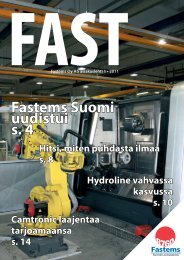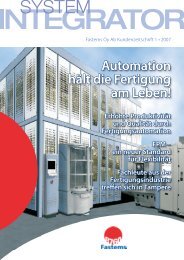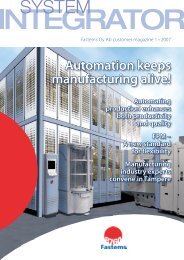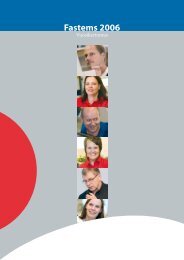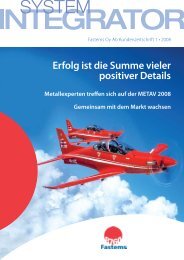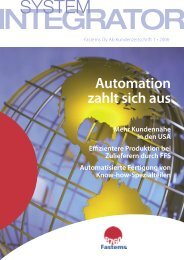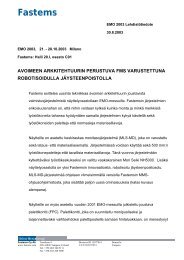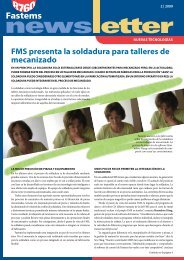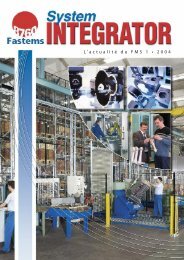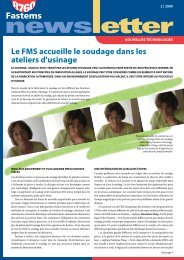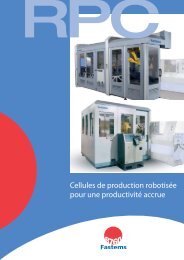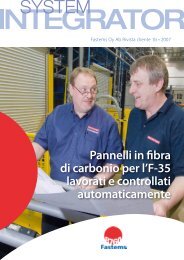System Integrator - Fastems
System Integrator - Fastems
System Integrator - Fastems
You also want an ePaper? Increase the reach of your titles
YUMPU automatically turns print PDFs into web optimized ePapers that Google loves.
SYSTEM<br />
INTEGRATOR<br />
<strong>Fastems</strong>OyAbcustomermagazine1•2011<br />
Batch size one?<br />
The solution<br />
is <strong>Fastems</strong>’<br />
lean system<br />
Majorautomationdriveat<br />
DoesburgComponents<br />
SandvikMining&ConstructionchoseFadector<br />
<strong>System</strong> <strong>Integrator</strong> | 1
MajorautomationdriveatDoesburg<br />
Components<br />
4<br />
8 Batch size one?<br />
The solution is<br />
<strong>Fastems</strong>’ lean system<br />
Contents1/2011<br />
Editorial ....................................................................................3<br />
Major automation drive<br />
at Doesburg Components ................................................4<br />
Tampere Manufacturing Summit 2011 .......................7<br />
Batch size one? The solution is<br />
<strong>Fastems</strong>’ lean system ..........................................................8<br />
Sandvik Mining & Construction chose Fadector –<br />
Improvements require comparable data ................. 12<br />
Service level 2+ takes care of the key system ......... 16<br />
<strong>Fastems</strong> Fastsimu – powerful offline<br />
programming software ................................................... 17<br />
The riding repairman ....................................................... 18<br />
PublishedbyFASTEMSOyAb<br />
2 | <strong>System</strong> <strong>Integrator</strong> <strong>System</strong> <strong>Integrator</strong> | 3<br />
No. 1/2011<br />
EDITOR-IN-CHIEF<br />
Jyrki Auer, <strong>Fastems</strong> Oy Ab<br />
jyrki.auer@fastems.com<br />
LAYOUT:<br />
Imageneering Oy<br />
EDITORIALADDRESS:<br />
<strong>System</strong> <strong>Integrator</strong><br />
<strong>Fastems</strong> Oy Ab<br />
Tuotekatu 4, 33840 TAMPERE,<br />
FINLAND<br />
Tel. +358 (0)3 268 5111<br />
Fax. +358 (0)3 268 5000<br />
PRINTEDBY:<br />
Kirjapaino Hermes Oy,<br />
Tampere, Finland 2011<br />
CONTRIBUTORS:<br />
Mika Laitinen<br />
Paul Quaedvlieg<br />
Giancarlo Giannangeli<br />
Jan Näström<br />
Esa Karppi<br />
Ari Lylynoja<br />
Jens von Weissenberg<br />
FASTEMS OY AB is the leading AT<br />
industry (Automation Technologies)<br />
company and supplier of factory auto-<br />
mation systems in Europe. We improve<br />
the competitiveness of our custom-<br />
ers through advanced automation<br />
solutions. Our extensive know-how<br />
in manufacturing technologies dates<br />
back to the early 1950s. Today <strong>Fastems</strong><br />
employs 380 people worldwide.<br />
E D I T O R I A L<br />
<strong>Fastems</strong> robotics<br />
offering<br />
strong focus on<br />
customer<br />
satisfaction<br />
I am a Sales Manager in our robotics division. My main task is to improve our customers’<br />
experience of <strong>Fastems</strong> by supporting our international sales organization.<br />
I will also look after selected customers, especially related to robotic finishing and<br />
deburring applications.<br />
Robotics is a field of strategic importance for <strong>Fastems</strong>. We have over 20 years of<br />
experience with over 1500 delivered robotics applications, which create a solid base<br />
to expand our robotics operations and be recognized as a strong robotics technology<br />
supplier.<br />
Deburring and finishing are among the main applications of robotics in a modern<br />
workshop. Health and safety policies as well as the increased need for constant quality<br />
create challenges that only automation can answer. To fulfill our customers’ requirements<br />
for increased flexibility and utilization, <strong>Fastems</strong> has released a new robot<br />
cell for finishing applications, the RFC (Robotic Finishing Cell).<br />
The RFC utilizes a sophisticated electric spindle system with automatic tool change<br />
based on ISO or HSK tool holders. Fully programmable process parameters combined<br />
with real-time monitoring ensure constant quality and a high utilization rate.<br />
A large tool rack and the option to introduce new tools with minimum effort provide<br />
a new level of flexibility. The cost to introduce a new tool is just the cost of a<br />
standard ISO or HSK tool holder and the tool itself. The tool system can be changed<br />
at any time and upgraded with the latest tool technology without changing the<br />
system hardware.<br />
The performance of the latest robot models enable new applications, such as drilling<br />
and threading, thereby making it possible to increase the capacity of the machine<br />
tools by using the robot cell for some of these tasks. The RFC takes robotics<br />
one step closer to machine tools. Even programming can be done with any available<br />
CAD/CAM system. <strong>Fastems</strong>’ new Fastsimu offline programming program allows<br />
robot cells to be programmed through the same steps as ordinary multi-axis machine<br />
tools.<br />
The RFC can be equipped with force control technology, a solution for applications<br />
where controlled material removal and ultimate quality are needed. Force control<br />
technology makes the contact force between the tool and the workpiece fully programmable.<br />
The process is controlled via real-time feedback control technology.<br />
Finally, the <strong>System</strong> <strong>Integrator</strong> customer magazine is one of our main marketing tools<br />
and it is now back in its thicker, more in-depth format. I am sure you will find it useful<br />
and interesting.<br />
Regards,<br />
MikaLaitinen
Major automation drive at<br />
DOESBURG<br />
COMPONENTS<br />
The robot cell can be seen clearly from above.<br />
At the top right is the Toyoda with a robot,<br />
in the center, the table and door, and at the<br />
bottom left the robot that works with the<br />
Quaser (photos: Paul Quaedvlieg).<br />
“There are three important reasons behind<br />
automation”, explains Jos Smeets, Director<br />
of Doesburg Components. “The first is<br />
the relatively high hourly wage in Europe,<br />
the second is the physical burden on the<br />
operators, and the third is the distinct lack<br />
of highly-trained individuals. Back in 2009,<br />
we were achieving 60 % less turnover, but<br />
now we are running at full production capacity,<br />
and CNC operators are almost impossible<br />
to come by. Of the 10 CVs that you<br />
receive, you might hope that one of them<br />
is from a person with sufficient experience;<br />
that is how difficult it is”. Over recent<br />
years, Doesburg Components has significantly<br />
increased its staffing level from 60<br />
to 103 people. “But further growth has to<br />
come primarily from automation,” explains<br />
Smeets. “We used the economic downturn<br />
to get in touch with new customers, and<br />
they are looking to purchase a great many<br />
products now and over the coming years.<br />
The number of braking system products<br />
that are processed on the new robot cell<br />
has been set to 150,000 parts per year, but<br />
the customer has already increased this demand<br />
to 240,000”.<br />
INVESTMENTS<br />
Doesburg Components has other major<br />
plans in the pipeline. The company intends<br />
Doesburg Components, part of the Gietburg<br />
group, will be investing heavily to expand its<br />
production over the coming years. Work is<br />
already underway with a special robot cell that<br />
processes cast-iron components for truck brake<br />
systems, and more robot cells will be added<br />
over the coming years. Doesburg Components<br />
is looking to produce more products with the<br />
same staffing level, something that will only be<br />
possible with a high degree of automation.<br />
By Paul Quaedvlieg<br />
to invest heavily in expanding its machinery.<br />
Smeets continues, “2011 looks like it<br />
will be a better year than 2008. A new generation<br />
of trucks and diesel engines is being<br />
made available, and these trucks feature<br />
increasingly more complex parts. Our engineers<br />
make regular visits to our customers<br />
to work on devising new designs for the<br />
new components. It is only by doing this<br />
that you are able to achieve fully-automated<br />
processing at the lowest possible overall<br />
cost price”.<br />
To ensure that the company is prepared<br />
for the future quantity of products, Smeets<br />
wants to invest around 10 million Euros<br />
in new, robotized and automated machining<br />
centers over a period from 2011 to<br />
2015. “But we place strict requirements on<br />
the machine and robot suppliers”, Smeets<br />
points out. “Up-time in the automotive industry<br />
is extremely important, so we only<br />
purchase machines from suppliers who can<br />
provide rapid service. We cannot find ourselves<br />
waiting a whole day for an engineer”.<br />
TWO ROBOTS<br />
The newest robot cell is the first part of<br />
the new investment drive. The robot cell<br />
includes two machining centers, a Quaser<br />
MK603S vertical machining center and<br />
a Toyoda FH630SX horizontal machin-<br />
ing center. The machines were supplied by<br />
Alfred van Meegen and Toyoda Europe in<br />
Krefeld, Germany, while <strong>Fastems</strong> was responsible<br />
for the automation and complete<br />
delivery of the turnkey project.<br />
The Quaser and Toyoda are positioned<br />
at right angles to one another. There are<br />
two robots, one in front of each machine.<br />
A buffer table is located between the two<br />
robots, onto which they place products and<br />
from where they pick them up again. “That<br />
is important to productivity”, explains Henk<br />
Kremers from Valkworks. Valkworks is the<br />
<strong>Fastems</strong> representative in the Benelux. “We<br />
based the design on the customer’s product.<br />
Does the product need to be machined on<br />
two sides? Does it need to be machined horizontally<br />
or vertically? How long is the machining<br />
time of the product and what is the<br />
robot’s handling time, including deburring?<br />
After looking at all of these aspects we decided<br />
that one robot would not be sufficient<br />
as it just wouldn’t be able to keep pace with<br />
the machining centers. So we decided to<br />
use two robots, with a buffer table between<br />
them”.<br />
4 | <strong>System</strong> <strong>Integrator</strong> <strong>System</strong> <strong>Integrator</strong> | 5<br />
HIGH SPEED<br />
Even the two Fanuc robots are barely<br />
able to keep up with the Quaser and the<br />
Toyoda. They are barely ever still. The first
obot, in front of the Quaser, picks up unprocessed<br />
cast iron parts from the material<br />
station. Four parts are clamped at once on<br />
the fixture on the Quaser. After machining,<br />
they are deburred by the same robot while<br />
still clamped on the fixture, after which the<br />
robot places them onto the buffer table.<br />
The second robot then picks up the parts<br />
from the table and clamps them on the fixture<br />
on the Toyota. At this point, only one<br />
side of the parts has been machined. Four<br />
parts are clamped at once on the fixture on<br />
this machine as well. The Toyoda machines<br />
the other side of the parts. Once machined,<br />
the second robot retrieves the parts again<br />
one by one and deburrs them. The finished<br />
parts are then placed back onto the buffer<br />
table, from where the first robot picks them<br />
up and delivers them back to the material<br />
station. This work cycle is repeated continuously.<br />
A door, which usually remains open, is<br />
located between the two robots. The buffer<br />
table is split into two halves, and the door<br />
can slide between the two. Kremers explains,<br />
“The door forms part of the safety<br />
system. If one of the two machines is out of<br />
action for measurements or minor maintenance,<br />
the other robot cell can still process<br />
10 to 12 parts. It is important to keep machine<br />
standstills to an absolute minimum”.<br />
COMPLEX<br />
After machining, the robots deburr<br />
the parts before returning them to the<br />
material station.<br />
In addition to the power of the robot<br />
cell, the greatest challenge of this turnkey<br />
project was integrating the robot software<br />
with the machine tool control. Kremers<br />
continues, “The robot cell has been designed<br />
to process around 30 parts per hour,<br />
from semi-finished cast iron to fully-machined<br />
and deburred end products. This<br />
means that the robot controls the machine.<br />
The robot tells the machine when it can begin<br />
machining. What is more, it is important<br />
that the robots never collide with one<br />
another”. <strong>Fastems</strong> took care of the entire<br />
integration process, including software.<br />
The main control cabinet is equipped<br />
with a remote connection to the <strong>Fastems</strong><br />
head office in Finland so should any<br />
problems arise, they are resolved from<br />
there immediately. Kremers concludes,<br />
DOESBURGCOMPONENTS<br />
“When the robot cell was delivered to<br />
Doesburg Components, it worked well<br />
pretty much from the outset. It was simply<br />
a matter of thorough preparation and<br />
knowing what the customer wants”.<br />
Doesburg Components of Nieuw-Bergen works primarily on the delivery and increasingly<br />
on the development and engineering of installation-ready components (cast-iron and<br />
processed cast-iron components) for the international truck and agricultural industry.<br />
Components are supplied to customers including DAF, Deutz, Leyland Trucks, Daimler,<br />
MTU, Wabco, Lely and McCormick. Doesburg Components is part of the Gietburg<br />
group, which also comprises Modelmakerij Hengelo, Gieterij Doesburg, Cirex in Almelo,<br />
Gietburg and the recently taken over Arbin Components of Venlo.<br />
For the third time, the international<br />
top-level conference Tampere<br />
Manufacturing Summit 2011 will be<br />
organized on 23-25 May in Tampere,<br />
Finland at Tampere Hall, the number<br />
one congress center in Finland.<br />
TampereManufacturingSummit2011<br />
The Federation of Finnish Technology Industries,<br />
Tampere University of Technology,<br />
VTT Technical Research Centre of Finland,<br />
Hermia Oy, and a number of leading<br />
Finnish industrial corporations are among<br />
the organizers.<br />
The Summit will bring together frontline<br />
industrial manufacturers and researchers<br />
to exchange opinions and ideas about<br />
different aspects of manufacturing and keys<br />
to improved global competitiveness and<br />
business profitability. The summit will be<br />
a type of executive and visionary seminar<br />
discussing the trends, visions, and challenges<br />
in today’s and tomorrow’s manufacturing<br />
industry. The summit program is<br />
based on invited presentations of internationally<br />
recognized experts from industry<br />
and academia discussing industrial best<br />
practices and scientific and technological<br />
advances, and breakthroughs in the field.<br />
The speakers represent Europe, Japan, Korea,<br />
and the United States equally.<br />
Further, the program includes visits to<br />
relevant companies as well as an exhibition<br />
illustrating the know-how of Finnish<br />
technology industries. Finally, there will be<br />
a networking and brokerage event which,<br />
among other things, aims to activate industry<br />
and academia for R&D collaboration<br />
over the borders.<br />
The two previous events (2007 and<br />
2009) were attended by more than 200 production<br />
manufacturing technology specialists<br />
coming from more than 20 countries.<br />
Also on both occasions, 60 % of the participants<br />
came from the industries whereas the<br />
rest were representatives of research, training,<br />
and public organizations. The feedback<br />
has been highly positive, participants of the<br />
industries emphasizing e.g. the international<br />
nature, high level of interest, and topicality<br />
of the summit.<br />
The objective of the Tampere Manufacturing<br />
Summit is to be a highly appreciated<br />
event on the European level, if not<br />
even more extensively, and to make it a<br />
preferred meeting point for manufacturing<br />
industries, research and other organizations<br />
as well as a showcase for the Finnish<br />
know-how and technology industry. In<br />
the long run, it is expected that there will<br />
be 500 participants attending. The interest<br />
shown in and feedback received from<br />
previous events proves it fully realistic that<br />
the summit can permanently become one<br />
of the events recommended and prioritized<br />
by different stakeholders in the field.<br />
This year, the theme of the summit is<br />
“Lean and Sustainable”, and we are expecting<br />
to have more than 300 participants.<br />
Attached you can see a tentative list of<br />
speakers who will be contacted and asked<br />
to give a presentation at the Summit. Many<br />
speakers have already confirmed their participation.<br />
It’s clear that some invitees will<br />
be prevented to contribute due to other<br />
commitments so that the final number of<br />
speakers will be approximately 50.<br />
You can see an overview of the summit<br />
program at the website:<br />
www.tamperemanufacturingsummit.fi/<br />
programme.<br />
More information:<br />
Reijo Tuokko, General Chair<br />
Mobile: +358 40 849 0270<br />
E-mail: reijo.tuokko@tut.fi<br />
Juhani Rantalainen, <strong>Fastems</strong> Oy Ab<br />
Mobile: +358 50 568 5004<br />
E-mail: juhani.rantalainen@fastems.com<br />
6 | <strong>System</strong> <strong>Integrator</strong> <strong>System</strong> <strong>Integrator</strong> | 7
Manufacturing companies are increasingly<br />
striving for machining process automation and<br />
flexibility. In this case, an automation system<br />
with two loading stations and a washing<br />
machine has yielded many benefits.<br />
Batch size one?<br />
The solution is<br />
<strong>Fastems</strong>’ lean system<br />
“ The<br />
Robuschi S.p.A. is a company that was<br />
founded in Parma, Italy in 1941. It started<br />
out as a small workshop that repaired centrifugal<br />
pumps employed in the agricultural<br />
sector. Nowadays, Robuschi is an international<br />
company that has three well-established<br />
product lines: centrifugal pumps,<br />
liquid ring vacuum pumps, and vacuum<br />
blowers. Each product line includes a variety<br />
of devices to meet any industrial needs.<br />
The company’s production and financial<br />
growth took place between the 1960s and<br />
the 1980s: continuous innovation resulted<br />
in the development of carefully designed<br />
high-precision electromechanical devices.<br />
By Giancarlo Giannangeli<br />
“The system is able<br />
to operate completely<br />
independently,<br />
even in unmanned<br />
production”<br />
company’s main product is the low<br />
pressure rotary blower that compresses the<br />
gas passing through it. The Parma-based<br />
company is one of the first manufacturers in<br />
the world for this type of product, and they<br />
have a widespread distribution network that<br />
includes seven subsidiaries<br />
and an extensive<br />
network of agents/distributors<br />
that encom<br />
passes 70 countries.<br />
Robuschi maintains<br />
its competitiveness<br />
with careful production<br />
planning and advanced<br />
automation systems:<br />
major investments in<br />
technology are made<br />
every year to improve<br />
products and processes.<br />
Investments were made<br />
in 2009 as well despite<br />
the unfavorable global<br />
economic situation and the resulting uncertainties<br />
in the market.<br />
AUTOMATION FOR OPTIMIZATION<br />
A new <strong>Fastems</strong> flexible manufacturing system<br />
(FMS) was taken into use in September<br />
2009. <strong>Fastems</strong> systems are able to integrate<br />
the widest variety of machinery and accessories<br />
to achieve a true automated factory,<br />
able to work day and night with minimal<br />
human operation.<br />
Michele Maestrini, Head of Process<br />
Technology at the Robuschi plant, tells how<br />
they came to this decision: “A horizontal<br />
machining center, Mazak FH10800, was<br />
operated in this area for several years. This<br />
machine tool was dedicated to manufacturing<br />
components that can reach two meters<br />
in rotational diameter: the most important<br />
parts of our blowers including body and rotors.<br />
The loads on the machining pallets are<br />
up to 1.60 meters high and the load weight<br />
can easily reach 3.5 metric tons. The machining<br />
center had excellent productivity<br />
and accuracy, and it was also equipped with<br />
a special tool magazine with 240 pots, created<br />
specifically to hold boring tools with<br />
machining diameters up to 650 mm.<br />
However, every time we needed to<br />
change the production lot it was necessary<br />
to replace the pallet and the machine tool<br />
was stopped for several hours for setup.<br />
Setup was also not an easy task, and it was<br />
All workpieces that have been processed on either<br />
machine tool are washed, transferred to the loading<br />
station, and unloaded from the system.<br />
8 | <strong>System</strong> <strong>Integrator</strong> <strong>System</strong> <strong>Integrator</strong> | 9
Michele Maestrini, Head of Process Technology at the Robuschi plant in Parma.<br />
In the loading and unloading area, the loading station transfers the loads diagonally in order to<br />
bring them to an ergonomic position for the operator.<br />
PAYATTENTIONTOECOLOGY<br />
Robuschi products, particularly the new ROBOX screw compressor units, high-efficiency<br />
“oil free” compressors, provide an effective response to the impact of electricity costs and<br />
result in lower environmental impact. Great thermodynamic efficiency, excellent volumetric<br />
efficiency, low noise level, no oil in the circuit, and reduced maintenance costs are<br />
some of the properties of these top-quality products.<br />
Extreme care is taken in both the design and manufacturing of all product lines (lobe<br />
blowers, screw compressors, vacuum pumps, and centrifugal pumps): “this allows us to<br />
position ourselves among the market leaders for equipment for the waste water treatment<br />
sector and pneumatic transport in various industrial applications.”<br />
certainly inefficient. In order to achieve<br />
reasonable payback periods for the tools,<br />
we were forced to increase the production<br />
lot sizes which also increased our inventory<br />
and related costs.<br />
We looked for a solution to the problem<br />
and also wanted to increase our production<br />
capacity, so we first decided to buy<br />
a second machine tool, and our choice was<br />
a new Mazak, because of the positive experiences<br />
on the reliability and efficiency of<br />
the existing FH10800. Then we also found<br />
an automation system that could integrate<br />
both machine tools, ensuring maximum<br />
flexibility of the production process, and in<br />
particular manage pallet transfers between<br />
the loading stations and machine tools.”<br />
COMPLETE PROCESS<br />
Robuschi considered various options, and<br />
after seeing other plants automated by<br />
<strong>Fastems</strong> they chose the Finnish company.<br />
The system is now fully operational and<br />
can accommodate all the workpieces in a<br />
special two-level storage rack, which has<br />
also freed floor space for future needs.<br />
All machines are served by a high-speed<br />
stacker crane, a rail-guided vehicle controlled<br />
wirelessly over a data photocell. Loading<br />
and unloading is performed in two<br />
loading stations that transfer the pallets<br />
diagonally to an ergonomic working height<br />
for the operators. The machine tools communicate<br />
with the automation system via<br />
Ethernet, creating a real plant intranet.<br />
The system also includes a pallet washing<br />
machine. Pallets are tilted 90 degrees and<br />
rotated on their horizontal axis while in the<br />
washing machine. This, together with the<br />
strong jets of water from the nozzles of the<br />
washing machine, removes chips and dirt<br />
that is usually quite difficult to clean. After<br />
machining, all workpieces are washed,<br />
transferred to the loading station, and unloaded<br />
from the system.<br />
MANUFACTURE WHAT IS NEEDED<br />
WHEN IT IS NEEDED<br />
Maestrini says: “Integration of the washing<br />
phase provides further benefits as it avoids<br />
the need for manual cleaning and having<br />
to take the workpieces outside the system,<br />
The number 8760 that <strong>Fastems</strong> emphasizes represents the number of hours in a year.<br />
The Finnish company strives to make all these hours into production hours.<br />
Giancarlo Ingenito, CEO of the Italian branch of the Tampere-based company, says:<br />
“A spindle should continuously produce chips, but a machine tool is normally working<br />
for no more than three thousand hours a year when optimally operated by a single<br />
operator. The wasted time is evident as the machine tool is in production use for only<br />
35 % of the time at best. The same machine tool, integrated into a <strong>Fastems</strong> system, may<br />
immediately at least double that number, with a dramatic improvement in the overall efficiency!<br />
According to us, setup, tooling, operator pauses and so on must not slow down<br />
the progress of work. We want to emphasize that even an older machine tool can still be<br />
productive when integrated into a <strong>Fastems</strong> automation system. The important thing is<br />
that it will (almost) never stop.”<br />
Heavy roughing and finishing operations are processed and they are characterized by<br />
significant removal speed.<br />
A pallet washing machine, in which the pallets are tilted 90 degrees and rotated on their<br />
horizontal axis, was also integrated into the system.<br />
10 | <strong>System</strong> <strong>Integrator</strong> <strong>System</strong> <strong>Integrator</strong> | 11<br />
8760<br />
not to mention the large quantities of chips<br />
that are now automatically managed. In the<br />
new system, a single operator can operate<br />
two machine tools, which used to be unimaginable.<br />
The system also includes loading<br />
stations, a storage rack, and a washing<br />
machine. Thus, we have dramatically<br />
increased the flexibility in this area; we can<br />
shift production from one machine tool to<br />
another at any time, instantly.<br />
We can manufacture workpieces in single<br />
batches now! Clamped workpieces are<br />
always waiting in the storage rack, ready to<br />
be transferred to the machine tools for machining,<br />
and the automation system makes<br />
it possible to prepare workpieces for either<br />
machine in either loading station.”<br />
The advantage of manufacturing small<br />
batches without additional costs is easily imaginable:<br />
“The operator enters the order coming<br />
from the office in charge of production<br />
into the system, and the system decides the<br />
priorities according to the deadlines and last<br />
minute requirements. Of course, the automatically<br />
proposed production schedule may<br />
be accepted or not. Each time a pallet is transferred<br />
to a machine tool, the system uploads<br />
the correct NC program to the machine tool,<br />
so there is no chance of human error. The system<br />
keeps track of tool use, and informs the<br />
operator when a tool has reached its expected<br />
life, so that tool maintenance or replacement<br />
can be performed quickly and efficiently. The<br />
machine tools use high-tech cutting materials,<br />
such as cubic boron nitride and silicon<br />
nitride, in many trimming and roughing<br />
processes.<br />
The system <strong>Fastems</strong> built for Robuschi is<br />
the first system in Europe that integrates two<br />
Mazak machine tools of these sizes: “the positioning<br />
of the stacker crane forks is so precise<br />
that it ensures full compliance with the<br />
tolerance; the weight of the pallet and special<br />
references ensure complete reliability. As it is<br />
clear from the number 8760 that is so dear to<br />
<strong>Fastems</strong>, the system is able to operate completely<br />
independently, even in unmanned<br />
production.”
Sandvik<br />
Mining & Construction<br />
chose Fadector –<br />
Improvements<br />
require<br />
comparable data<br />
Sandvik Mining & Construction, SMC,<br />
is a world-leading supplier for mining<br />
industry and heavy contracting. In this<br />
business, reliability means everything.<br />
Yet SMC chose a system that did not exist<br />
for production tracking.<br />
- We have good experiences of <strong>Fastems</strong> and<br />
know that corresponding systems in their<br />
FMS plants are very reliable, Otto Montell,<br />
project manager at MC explains.<br />
SMC has a total of 14,500 employees<br />
and they have production plants all over<br />
the world. The main office is in Sandviken,<br />
Sweden, which is also where drill crowns,<br />
drill rods, and adapters are produced.<br />
- The manufacturing is controlled by customer<br />
orders and the same products are<br />
- Fadector has a simple interface that<br />
facilitates the work of the operators, says<br />
Otto Montell, project manager at Sandvik<br />
Mining & Construction.<br />
manufactured at different factories near the<br />
customers, Otto Montell tells.<br />
A need for production tracking has existed<br />
already for a long time to guarantee<br />
quality and make the production more efficient.<br />
In the beginning, tracking was carried<br />
out on paper but computerized production<br />
tracking was introduced in the end<br />
of the 1990s. These systems were developed<br />
through initiatives from individual factories<br />
which resulted in several systems with<br />
different functions and different methods<br />
for measuring.<br />
- It ended up with us discussing about<br />
different things when comparing the<br />
plants. We needed a common benchmark,<br />
Otto Montell explains.<br />
HISTORY AND POSSIBILITIES<br />
An enquiry was sent to several potential<br />
suppliers together with a description of<br />
what the system should be able to perform.<br />
<strong>Fastems</strong> was one of the companies that<br />
replied. It was not able to provide a ready<br />
product, but instead provided a detailed<br />
description of the Fadector system that was<br />
in development.<br />
- <strong>Fastems</strong> fulfilled all of the must-have<br />
requirements and the description even<br />
contained many of our wishes regarding<br />
functions and future improvement possibilities,<br />
Otto Montell says.<br />
Usually SMC would not buy a pig in<br />
a poke like this, but here we had a history<br />
that indicated that the result would be what<br />
we were looking for.<br />
SMC has <strong>Fastems</strong> FMS systems at its<br />
factories in Tampere and Lahti. These include<br />
several of the demanded functions<br />
and our experience is that the devices and<br />
support work extremely well. To put it very<br />
simply, you could say that Fadector is an<br />
FMS without hardware.<br />
- The history combined with us being<br />
12 | <strong>System</strong> <strong>Integrator</strong> <strong>System</strong> <strong>Integrator</strong> | 13
a part of the development work made us<br />
choose <strong>Fastems</strong>, Otto Montell says.<br />
TESTED IN THREE FACTORIES<br />
The first installations were made in 2008 at<br />
three different factories, two in Sweden and<br />
one in Finland. Fadector worked well already<br />
from the beginning and the plan was<br />
to roll out the system all over the world. But<br />
then came the financial crisis, the investments<br />
were postponed and the work was<br />
focused on fine tuning the systems already<br />
installed. When the demand then increased<br />
there was a more tested and complete system<br />
to proceed with. Today Fadector is installed<br />
at ten sites all over the world and in<br />
the future all sites are going to have it.<br />
The project has three main goals:<br />
1: To shorten the response time for the<br />
operator. One operator is responsible for<br />
several machines. Time is lost when the<br />
operator fails to notice that a machine has<br />
performed its task and is standing still. By<br />
making stand stills visible more production<br />
time becomes available.<br />
2: Reliable input in improvement work and<br />
receipt of the improvement work having the<br />
desired effect.<br />
3: Impartial identification of the factory or<br />
the factories that do best a certain operation,<br />
in order to spread knowledge and experience<br />
to other units.<br />
- We aim at having the same machines<br />
at all factories. The difference is in the rate<br />
of automation. Here in Sweden loading and<br />
unloading is handled by robots but in lowcost<br />
countries operators do these tasks. The<br />
machining again is the same everywhere,<br />
says Otto Montell.<br />
EFFICIENT SUPPORT<br />
A precondition for the functioning of global<br />
benchmarking is that everyone uses the<br />
same measuring tools. Measurements must<br />
never be questioned, which was the case<br />
when every factory had its own system.<br />
The key to success is that the operators do<br />
not experience the system as a burden. It<br />
must help the operator with his work and<br />
not make it more complicated. Thus a lot<br />
of work has been put down on the interface<br />
that <strong>Fastems</strong> has developed in coopera-<br />
tion with SMC. The result is such an easy<br />
handling that the system is almost self-instructive.<br />
- In countries with employees used to<br />
working with computers barely any training<br />
is needed and what is needed we can take<br />
care of by ourselves, says Otto Montell.<br />
However, SMC has strict requirements<br />
on support. The system must work 24<br />
hours per day, seven days a week. Possible<br />
problems must be remedied immediately.<br />
<strong>Fastems</strong> is able to offer remote support over<br />
the internet that is as efficient as having personnel<br />
on site.<br />
FACILITATES THE OPERATOR’S WORK<br />
SMC sees Fadector as something more than<br />
a functional and ready system. It is at the<br />
same time a platform for future development.<br />
The next step will be reporting of rejected<br />
parts where the operator writes down<br />
an error code for what has happened. After<br />
this the plan is to monitor e.g. power levels<br />
and temperatures for more efficient preventive<br />
maintenance.<br />
Technically, Fadector’s potential is almostunlimited,<br />
but Otto<br />
Montell emphasizes<br />
that<br />
the system basically<br />
consists of<br />
measurement<br />
values that<br />
are saved in a<br />
database. The<br />
results will not<br />
show until the<br />
operators and<br />
supervisors use<br />
the system.<br />
- Therefore,<br />
the most important<br />
thing<br />
is a simple<br />
interface that<br />
facilitates the work of the operator as well<br />
as functioning support services. Fadector<br />
fulfills these requirements, Otto Montell<br />
combined with a simple interface<br />
and future development<br />
possibilities made us choose<br />
Fadector for production<br />
monitoring at all factories”<br />
summarizes. “Good experiences of <strong>Fastems</strong><br />
14 | <strong>System</strong> <strong>Integrator</strong> <strong>System</strong> <strong>Integrator</strong> | 15
SERVICELEVEL2+<br />
takes care of the key system<br />
<strong>Fastems</strong> Oy Ab has expanded the Lifetime<br />
care services it offers. Level 2+<br />
has been added to the available services.<br />
Service level 2+ includes remote<br />
Teleservice support at a fixed annual<br />
fee as in Service Level 1 and preventive<br />
maintenance work in accordance<br />
with the maintenance plan as in Service<br />
Level 2. As a new feature, it also<br />
includes an analysis of the control system<br />
status by the Teleservice team.<br />
Seven customers have participated in pilot testing of the new service<br />
concept, and the first level 2+ service agreements have been<br />
signed thanks to the pilot testing. There are currently ten FMS<br />
systems around the world that benefit from the level 2+ service<br />
agreements. Sven Isaksson, <strong>Fastems</strong> Area Service Manager for<br />
Scandinavia, tells that with the level 2+ service agreement the customer<br />
can gain a deeper understanding of the control system, discover<br />
areas where production can be improved, and increase the<br />
competence of the operating personnel. The data can also be used<br />
for improving the availability and utilization rate of the system.<br />
In addition to the technical benefits, the level 2+ service agreement<br />
also reduces administrative costs. The costs can be anticipated<br />
and services can be ordered flexibly without bureaucracy<br />
thanks to the fixed annual fee. In practice, ordering the needed<br />
services can be brought to shop-floor level in the organization,<br />
which enables swift reaction to production problems.<br />
Service level 2+ provides reliable and accessible data on how<br />
the system has performed, how it has been utilized, and in case of<br />
problems, what measures are needed. Because this data is available<br />
for maintenance personnel already before the on-site visit, fewer<br />
visits are needed, which in turn means direct savings for the customer.<br />
Further information:<br />
Esa Karppi<br />
Team Leader, Teleservice<br />
<strong>Fastems</strong>Fastsimu<br />
powerful offline programming software<br />
Offline programming (OLP) is becoming a requirement<br />
in many robotics applications, especially<br />
deburring and finishing. However, most of<br />
the OLP programs on the market are designed for<br />
general use, which is why they often lack some<br />
essential features that are needed for these particular<br />
applications. This makes programming<br />
with a general OLP program complex, time consuming,<br />
and clearly not user-friendly.<br />
<strong>Fastems</strong> Fastsimu is a powerful offline programming and simulation<br />
program that is specifically designed for robotized deburring and<br />
finishing applications.<br />
Fastsimu is designed to be easy to use and fast to program. The<br />
user interface only includes tools that are required for the work at<br />
hand, nothing else. Fastsimu is based on a software platform created<br />
by Visual Components, which provides outstanding performance<br />
and functionality.<br />
CNC tool paths from any CAD/CAM software can be imported<br />
to Fastsimu and further converted into a robot program. Fastsimu<br />
includes special tools for manipulation of large tool paths, which are<br />
typical in finishing applications. Values for a robot’s external axes,<br />
rotary table, and/or linear track are assigned automatically, which<br />
makes programming straightforward and easy.<br />
Fastsimu supports various 3D CAD formats for importing<br />
models of fixtures and workpieces. There are powerful tools for<br />
creating and manipulating deburring paths by using features from<br />
CAD models. Fastsimu detects surfaces, holes, and edges of the<br />
models and creates tool paths automatically. Calibration tools are<br />
used for minimizing the differences between the real robot cell and<br />
its virtual copy.<br />
Simulation of the robot program includes robot movements,<br />
reachability analyses, collision and near-miss detection, automatic<br />
tool changes, and cycle time reporting. After a successful simulation,<br />
the program is downloaded from the PC to the robot controller.<br />
When using Fastsimu, production stops due to programming<br />
are short. This is clearly a huge advantage compared to online programming.<br />
16 | <strong>System</strong> <strong>Integrator</strong> <strong>System</strong> <strong>Integrator</strong> | 17
I’ve worked for <strong>Fastems</strong> since<br />
May 2007 – some four years now, in<br />
the Teleservice team. The name might<br />
seem quaint, but back when the first<br />
modem-equipped system controllers<br />
were delivered, that was exactly what<br />
the service was about: helping our<br />
customers with their systems over a<br />
remote connection (read: phone line).<br />
By Jens von Weissenberg<br />
These days, most of <strong>Fastems</strong>’ FMS, FPM, and FPC customers<br />
will be in contact with me or my teammates sooner or later.<br />
Teleservice is there when a new system is taken into use, when<br />
small or big parameter and/or programming changes are called<br />
for, and – to put it simply – when the system presents a challenge<br />
for the customer.<br />
Thanks to the remote connections we have to the systems, most<br />
situations that arise can be resolved without sending a service engineer<br />
on site – unless, of course, the customer requests one or the<br />
challenge calls for more hands on deck.<br />
A full working day for me will include anything between 4 to 10<br />
direct customer contacts in Finnish, Swedish, English, or German.<br />
RIDING<br />
T I M E O F F T I M E O F F<br />
THE RIDING<br />
REPAIRMAN<br />
I used to go horseback riding in my early teens, but being the<br />
only boy around the stables and meeting one really big, scary<br />
horse made me give it up. Of course, no one told me that if I<br />
The writer of this column, <strong>System</strong> Support Specialist Jens von Weissenberg,<br />
on a riding tour with his two daughters.<br />
would have hung in there a couple more years, being the only guy<br />
would have had its advantages…<br />
In the fall of 2005, my older daughter wanted to start riding, so<br />
we asked around and were recommended a nice riding school in<br />
Viitapohja. I stood by the paddock for my daughter’s first lesson,<br />
but after that I had to get back in the saddle myself, so to speak.<br />
I’ve been at it for the last five years now, and I slowly start to<br />
feel like I’ve learned something. Riding is a constant challenge –<br />
you cannot lose focus during the lesson, the horse will sense it<br />
right away. Riding is always a team effort, but only one of the team<br />
can lead. If it ain’t you, it’ll be the horse! Still, you have to be very<br />
aware of the horse at all times. The best riding always comes from<br />
you coaxing, rather than forcing the horse to follow your will.<br />
18 | <strong>System</strong> <strong>Integrator</strong> <strong>System</strong> <strong>Integrator</strong> | 19<br />
REPAIRING<br />
When my spare time isn’t taken up by horses or renovating my<br />
family’s old house, I like to keep up my luthiery skills. I’ve studied,<br />
amongst other things, stringed instrument making – I have a luthier’s<br />
diploma in guitar making. As much as I love building new<br />
instruments, most of my instrument-related work is repairs and<br />
setups. I keep a website that generates some contacts, but most of<br />
it is word of mouth. In a way, instrument repair doesn’t differ too<br />
much from my Teleservice work – in both cases the customer has<br />
something that doesn’t quite do what it’s supposed to, or, at least,<br />
could do it better if set up and ‘tuned’ properly.<br />
I’ve built electric and acoustic guitars, basses, kanteles (the<br />
Finnish harp), and some odd stuff like drum triggers and stomp<br />
boxes. I’ve repaired, set up, modified, or restored a lot of different<br />
stringed instruments. One of the best rewards I can get is when a<br />
customer tries out his guitar, bass, or mandolin and says: “Wow! I<br />
never knew it could play like this!”
AUTOMATE<br />
NOW!<br />
20 | <strong>System</strong> <strong>Integrator</strong><br />
Combined autoloading<br />
and finishing cell<br />
• automatic tool change<br />
• electric power tooling<br />
• increased productivity<br />
www.fastems.com<br />
at<br />
Hall 12<br />
Stand C20<br />
New MMS5 FMS control system<br />
• Adapts automatically to changes in the<br />
production environment<br />
• Effortless loading area operation with<br />
FMS Autopilot<br />
• Complete production traceability<br />
High-volume LEAN<br />
manufacturing system<br />
• fewer clamping fixtures<br />
• longer unmanned periods<br />
• optimum use of machine capacity



